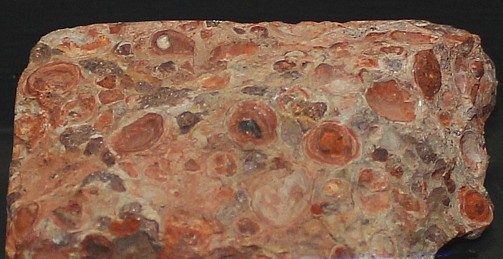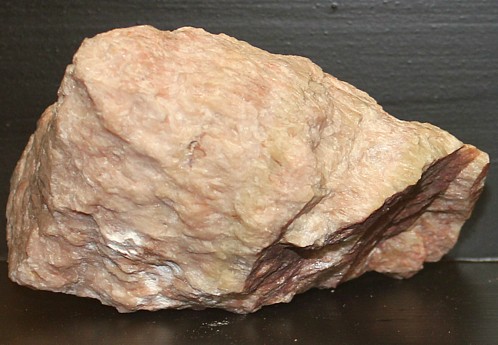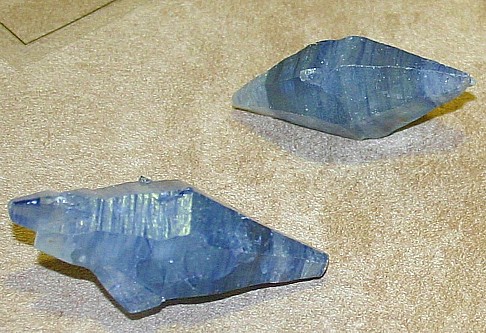Aluminum is not found in a
free state, but in combination constitutes 8.16 per cent, of the earth's
crust, and is the most abundant of metals. Unlike other metals, however, its
occurrence, with the exception of the fluorides, is restricted to minerals
containing oxygen. Aluminum is an important constituent of a large number of
minerals, notably
corundum,
bauxite, diaspore, hydrargillite, cryolite,
alunite, and a large number of silicates. It is an essential
constituent of clay,
mica, and
feldspar, and occurs in smaller amounts in many rocks. It is
most abundantly found in the rock-making silicates, in the majority of which
it is an essential constituent. The minerals which can be used as ores of
the metal are, however, few in number, the only one at present of importance
being bauxite. The enormous amounts of aluminum contained in the various
silicates are not yet available because of the difficulty and expense of
extraction. As a result, the chief industrial source of aluminum and its
compounds is bauxite, though minor amounts come from cryolite, alunite, and
shales. Such articles of commerce as potter's clay, slates, china clay
(kaolin), fuller's earth, etc., are silicates, while oxides occur as
bauxite, corundum, and emery.
Aluminum is valuable because of its low density and because it is not easily
oxidized or corroded. The metal aluminum is produced in the electric furnace
by the reduction of alumina obtained from bauxite. It is a silver-white,
durable, low cost metal, capable of taking a high polish. Owing to its low
specific gravity (2.58), it is of great value in the manufacture of many
articles where lightness is of importance. It melts at 657 C., and alloys
with most metals and some non-metals. Aluminum is used in the manufacture of
many articles where strength with lightness is required. Aluminum is
produced in Scotland, United States, France, and Switzerland, all localities
where hydro-electrical installations are practical. The pure metal is
prepared from aluminum oxide produced from processed bauxite by an
electrolytic process which takes place in a bath of fused cryolite. The tank
in which the reaction takes place is lined with carbon and forms the
cathode, while graphite rods suspended in the bath serve as the anode. The
metal collects in the bottom of the tank and is drained away. Prior to the
discovery of this process, the metal was difficult to produce and for
decades after its discovery, metallic aluminum more expensive than
gold. It is now the metal of second greatest production and
use by mankind, behind only iron. As such it is a critical and important
metal of industrial commerce.
It is a good electrical conductor and to some extent is replacing copper used for that purpose. It is used in many alloys, particularly with magnesium, zinc, copper and nickel. It is used in small amounts in casting steel in order to take up any oxygen in the melt and also to prevent porosity in the metal. The light alloys of chief importance are those with zinc and containing a small proportion of magnesium. Sheets and tubes and castings of aluminum are used wherever a light weight metal is desired, for instance in the manufacture of certain parts of airplanes and automobiles. Aluminum is used in the manufacture of cooking utensils, cans and food containers, aluminum foil, as a substitute for lithographic stones and zinc plates, as powder in the manufacture of metallic paints, etc. It is also widely used in the form of its salts, chiefly alum and aluminum sulphate, to harden paper, in the purification of water as mordants in dyeing, in baking powders, in medicine as heartburn antacids, etc. Aluminum and iron oxide are mixed in a finely divided state to form the material known as thermite. When this mixture is ignited the heat of the combustion of the aluminum is so great that it can be used in welding iron and steel. The energetic action of finely divided aluminum on other metallic oxides, when heated together, is taken advantage of in the "Thermite" processes for the production of metallic chromium, manganese, molybdenum, tungsten, uranium, etc. The aluminum combines directly with the oxygen of these oxides, and the heat evolved by the reaction is sufficient to promote the fusion of the reduced metal.
Bauxite: There are, commercially speaking, two kinds of bauxite, red and white. While the principal use of bauxite is for the manufacture of aluminum, considerable quantities of the mineral are used as abrasives and in the manufacture of aluminum compounds. Because it is so difficult to melt, lower grades of bauxite are used as refractory materials i.e., for the manufacture of bricks and for furnace and converter linings. For chemical purposes the white bauxite containing only a trace of iron is used, but for the manufacture of metallic aluminum, iron is not harmful, although the presence of more than 3 per cent, of silica or of titanium oxide is objectionable.
Alunite has been suggested as a source of aluminum and potash, and when this mineral is calcined and leached, potassium sulfate can be recovered together with pure alumina, which is eminently suited to the manufacture of aluminum. Aluminum oxide in the form of corundum is, with the exception of diamond, the hardest mineral known, and is used as an abrasive. Grinding "wheels" are made by the incorporation of a binding medium, such as shellac, with crushed corundum. The mining and preparation of corundum is costly, but there is a steady demand for the article. Emery is an impure and less hard form of corundum. Corundum in the form of sapphire and ruby is also an important gemstone. Artificial corundum, marketed under the names of "Alundum" and "Aloxite," is made by fusing bauxite in the electric furnace.
Origin of bauxite and laterite. The action of atmospheric influences on rocks containing felspars and other aluminum silicates containing various bases, results in the decomposition of these silicates, and the formation of hydrated products. In regions where the climate is temperate, and the rainfall frequent, the alkaline products of decomposition are largely carried off in solution in the abundant surface waters, and amorphous hydrated silicates of aluminum, the plastic ingredients of rock-clays and mudstones, remain as an end-product of weathering, usually mixed with quartz and other resistant minerals.
In those hot countries where a long dry season alternates with a wet season, the change goes a step further. Under these conditions the hydrated silicate of aluminum and free silica are attacked, and hydrated alumina is the end-product of weathering. The explanation of this is probably to be found in the fact that, under such climatic conditions alkaline salts accumulate in the soil, and yield solutions that can attack silica and aluminum silicates. The tropical weathering products thus produced are laterites; and though these are characterized by the presence of amorphous hydrated alumina, they usually contain other amorphous hydrated oxides in large amount, especially limonite and titanium dioxide. More rarely they contain manganese oxide, chromium oxide, and nickel silicate, while there may be a residue of undecomposed hydrated aluminum silicate and quartz, together with ilmenite, rutile, zircon, gold, cassiterite, and other minerals that have resisted decomposition.
It is therefore convenient to use the term laterite in a broad petrographical sense, and to apply the term bauxite in a mineralogical sense to the amorphous hydrated alumina which is the characteristic ingredient of laterites, and which in a more or less impure condition constitutes the bauxite of commerce. Laterite manifests a tendency to segregation. Segregated masses of iron oxide and bauxite in pisolitic forms are commonly found among laterites. As already mentioned the pisolitic concretions are stated to have in some cases all the essential characteristics of diaspore. Gibbsite is frequently present in the cracks and cavities of laterite and bauxite, and bauxite may become completely changed into hydrargillite.
Occurrence and distribution. Bauxite is widely distributed in many areas, but the chief current producer is Australia, from which comes almost one third of the earth’s output. Large deposits also occur in Russia, India, China, Brazil and Guiana, and these countries are also important producers of bauxite. Countries in which it was once mined include France, United States, Ireland, and Italy.
Return
to Metal Ores Page:
Precious and Base Metal Ores

Bauxite, shown above, is the commercially important ore of Aluminum. It consists of a mixture of different aluminum oxides and is converted to the metal by an electrolytic process.

Alunite is an aluminum mineral that has been proposed as a potential aluminum ore.

These are well formed crystals of sapphire, a well known gem. Sapphire and Ruby are made of Aluminum oxide and could be an ore of the metal. Crude and impure Corundum is used as an abrasive.
